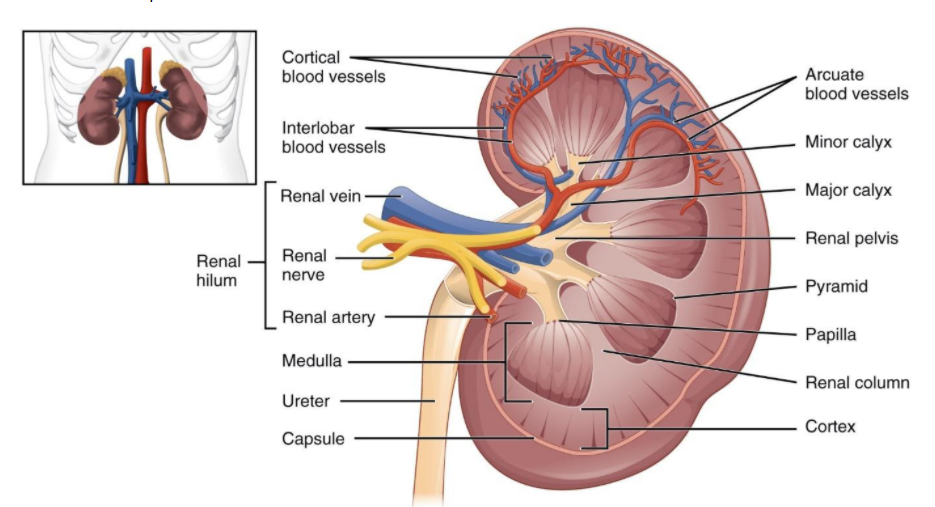
Describe the structure and physiology of the kidney of a mammal?
Answer
557.4k+ views
Hint: Kidneys are two bean shaped organs found in the vertebrates. The nephron is the structural and functional unit of the kidney.
Complete answer:
Nephrons are the urine-producing functional structures of the kidney.
Structure of the kidney – internally the kidneys has 3 regions, an outer cortex, a medulla in the middle, and the renal pelvis in the region known as the hilum of the kidney.
The hilum is the concave region of the bean-shaped area where blood vessels and nerves enter and exit the kidney. It refers to the exit point of ureters.

This is the structure of mammalian kidneys consisting of two bean structures. The renal cortex and the renal pyramids constitute the functional portion of the kidney along with the building structure called nephrons.
The renal corpuscle consists of a tuft or pack of capillaries called a glomerulus and a Bowman’s capsule. The renal tubule extends from the capsule.
Physiology of mammalian kidney:
> The renal system of humans consists of kidney, urethra, and the ureters. The main function of the renal system is to filter approximately 200 liters of fluid a day from renal blood flow that allows toxic, metabolic wastes products, and excess ions to be excreted out.
During this process, all the essential components are kept in the blood.
The renal system also maintains the osmotic balance and pH of the body fluids.
Physiology of kidneys is called renal physiology. This covers all the function of kidneys, maintaining acid-base balance, regulation of fluid, ions like sodium, potassium.
Most of physiology depends on the smallest working functional unit of the kidney. It begins with the filtration component that filters the blood entering the kidney. It consists of special cells that help in the reabsorption of water and small molecules. The secretion of wastes from the blood into the urine is also done by these cells.
Main function is to maintain proper blood flow to be received and filtered. This is performed by millions of small units of filtration known as Renal corpuscle. It is regulated by GFR (Glomerular filtration Rate).
Note:
Formation of urine, filtration, reabsorption, secretion and the excretion are the main parts of the human renal system.
Excretion= Filtration – Reabsorption + Secretion.
Complete answer:
Nephrons are the urine-producing functional structures of the kidney.
Structure of the kidney – internally the kidneys has 3 regions, an outer cortex, a medulla in the middle, and the renal pelvis in the region known as the hilum of the kidney.
The hilum is the concave region of the bean-shaped area where blood vessels and nerves enter and exit the kidney. It refers to the exit point of ureters.

This is the structure of mammalian kidneys consisting of two bean structures. The renal cortex and the renal pyramids constitute the functional portion of the kidney along with the building structure called nephrons.
The renal corpuscle consists of a tuft or pack of capillaries called a glomerulus and a Bowman’s capsule. The renal tubule extends from the capsule.
Physiology of mammalian kidney:
> The renal system of humans consists of kidney, urethra, and the ureters. The main function of the renal system is to filter approximately 200 liters of fluid a day from renal blood flow that allows toxic, metabolic wastes products, and excess ions to be excreted out.
During this process, all the essential components are kept in the blood.
The renal system also maintains the osmotic balance and pH of the body fluids.
Physiology of kidneys is called renal physiology. This covers all the function of kidneys, maintaining acid-base balance, regulation of fluid, ions like sodium, potassium.
Most of physiology depends on the smallest working functional unit of the kidney. It begins with the filtration component that filters the blood entering the kidney. It consists of special cells that help in the reabsorption of water and small molecules. The secretion of wastes from the blood into the urine is also done by these cells.
Main function is to maintain proper blood flow to be received and filtered. This is performed by millions of small units of filtration known as Renal corpuscle. It is regulated by GFR (Glomerular filtration Rate).
Note:
Formation of urine, filtration, reabsorption, secretion and the excretion are the main parts of the human renal system.
Excretion= Filtration – Reabsorption + Secretion.
Recently Updated Pages
Master Class 12 Business Studies: Engaging Questions & Answers for Success

Master Class 12 Economics: Engaging Questions & Answers for Success

Master Class 12 English: Engaging Questions & Answers for Success

Master Class 12 Maths: Engaging Questions & Answers for Success

Master Class 12 Social Science: Engaging Questions & Answers for Success

Master Class 12 Chemistry: Engaging Questions & Answers for Success

Trending doubts
What are the major means of transport Explain each class 12 social science CBSE

Which are the Top 10 Largest Countries of the World?

Draw a labelled sketch of the human eye class 12 physics CBSE

Explain sex determination in humans with line diag class 12 biology CBSE

The pH of the pancreatic juice is A 64 B 86 C 120 D class 12 biology CBSE

Give 10 examples of unisexual and bisexual flowers




